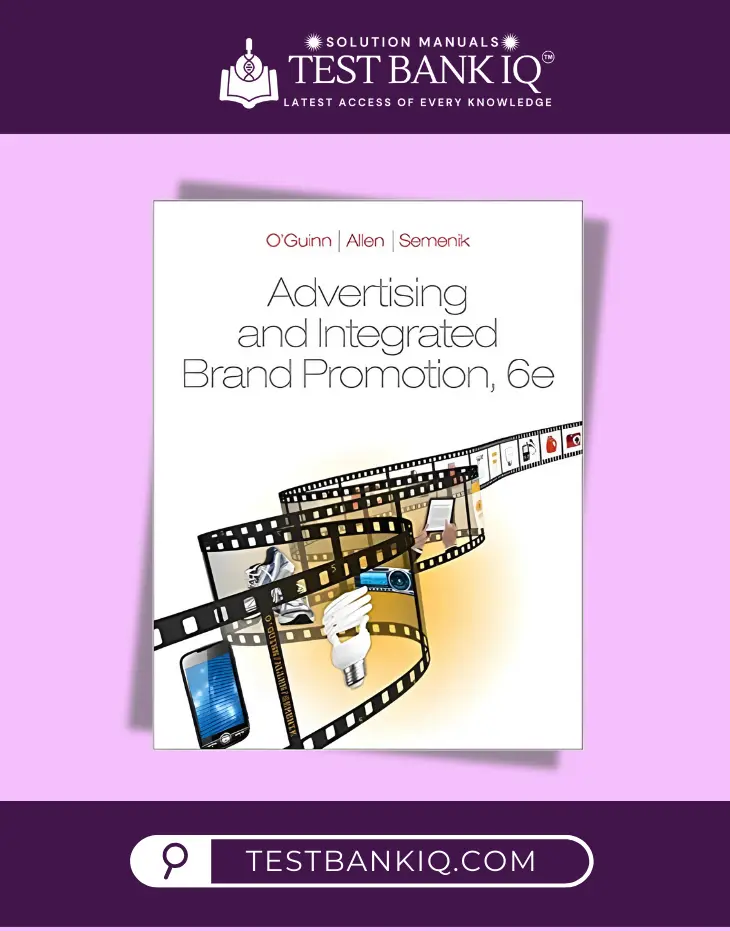Test Bank For Advertising And Integrated Brand Promotion 6th Edition By Thomas O’Guinn
Chapter 3 – The History of Advertising and Brand Promotion
TRUE/FALSE
1.When the Western world turned to capitalism as the foundation of an economic system, the foundation was also laid for advertising.
ANS: T DIF: Easy REF: p. 81 OBJ: 3-1
NAT: AACSB Communication | CB&C Model Promotion TYP: Knowledge
2.Advertising is a source of information and persuasive ideas regarding a society’s products and services, but it is no longer essential to the competition for resources in a capitalistic society.
ANS: F DIF: Easy REF: p. 81 OBJ: 3-1
NAT: AACSB Communication | CB&C Model Promotion TYP: Comprehension
3.The Industrial Revolution was an economic force that yielded the need for advertising.
ANS: T DIF: Easy REF: p. 81 OBJ: 3-1
NAT: AACSB Communication | CB&C Model Promotion TYP: Knowledge
4.The expansion and connection of the U.S. highway system by the late 1860s created the beginnings of a nationwide distribution network.
ANS: F DIF: Easy REF: p. 82 OBJ: 3-1
NAT: AACSB Technology | CB&C Model Distribution TYP: Knowledge
5.In the late 1880s, a few companies began putting names and labels on previously unmarked products, and branding began.
ANS: T DIF: Moderate REF: p. 82 OBJ: 3-2
NAT: AACSB Strategy | CB&C Model Promotion TYP: Comprehension
6.Folgers coffee, Miller beer, Dial soap, and Pepsi-cola were some of the first branded goods on store shelves.
ANS: F DIF: Moderate REF: p. 82 OBJ: 3-2
NAT: AACSB Strategy | CB&C Model Promotion TYP: Comprehension
7.Widespread branding of products among almost limitless categories, in the way we think of it today, was seen in the U.S. by the late 1800s.
ANS: F DIF: Easy REF: p. 82 OBJ: 3-2
NAT: AACSB Strategy | CB&C Model Promotion TYP: Comprehension
8.It was found early on that branding has its own power. If consumers demanded Ivory soap, then grocers had better stock it.
ANS: T DIF: Moderate REF: p. 82 OBJ: 3-2
NAT: AACSB Communication | CB&C Model Strategy TYP: Comprehension
9.In the late 1800s, consumers were willing to pay more for brands than for unmarked commodities, even if they were otherwise identical.
ANS: T DIF: Difficult REF: p. 82 OBJ: 3-2
NAT: AACSB Communication | CB&C Model Pricing TYP: Comprehension
10.During the mid-1800s, a number of magazines were launched, though circulation was limited because they were designed for socially privileged audiences and not the mass public.
ANS: F DIF: Easy REF: p. 83 OBJ: 3-2
NAT: AACSB Communication | CB&C Model Customer TYP: Knowledge
11.In the mid-1800s, mass-circulation magazines began to make national advertising possible, and national advertising began to make national brands possible.
ANS: T DIF: Difficult REF: p. 83 OBJ: 3-2
NAT: AACSB Reflective Thinking | CB&C Model Promotion TYP: Comprehension
12.Without the rise of mass media, there would have been no national brands because there would have been no national advertising.
ANS: T DIF: Difficult REF: p. 83 OBJ: 3-2
NAT: AACSB Reflective Thinking | CB&C Model Promotion TYP: Comprehension
13.Media vehicles—television networks, radio stations, newspapers, magazines, and websites—exist so they can sell audiences and make money.
ANS: T DIF: Difficult REF: p. 83 OBJ: 3-2
NAT: AACSB Communication | CB&C Model Promotion TYP: Comprehension
14.The Chicago Tribune featured what is considered the first newspaper ad in the U.S., when it printed two notices under the heading of “Advertising” in the early 1880s.
ANS: F DIF: Moderate REF: p. 83 OBJ: 3-3
NAT: AACSB Communication | CB&C Model Promotion TYP: Knowledge
15.Newspaper publication expanded rapidly during the Industrial period, to the point where circulation of the dailies was up to 10 million copies a day nationwide by 1850.
ANS: F DIF: Moderate REF: p. 84 OBJ: 3-3
NAT: AACSB Communication | CB&C Model Distribution TYP: Comprehension















There are no reviews yet.